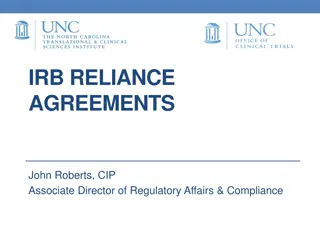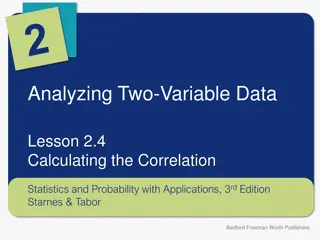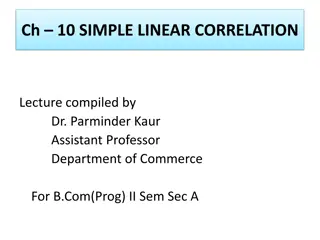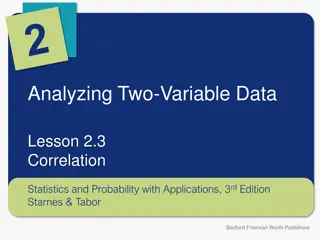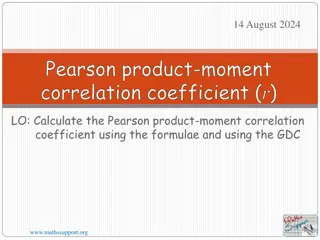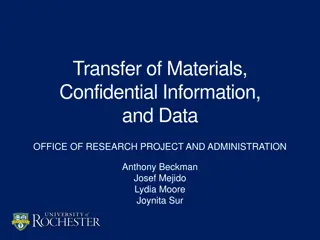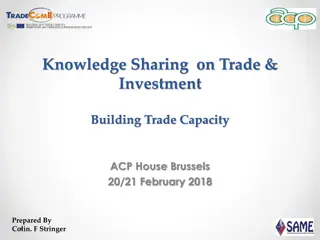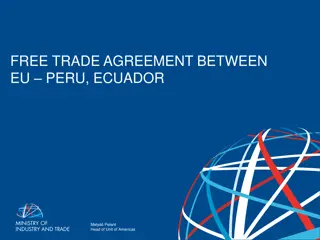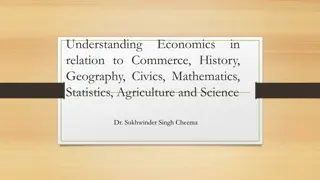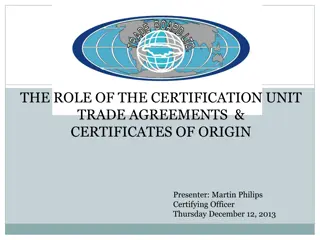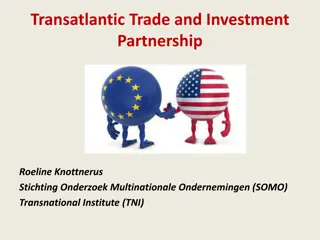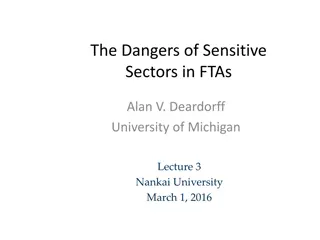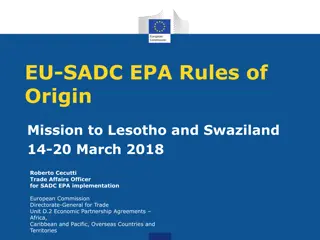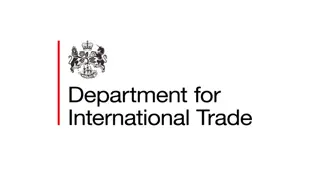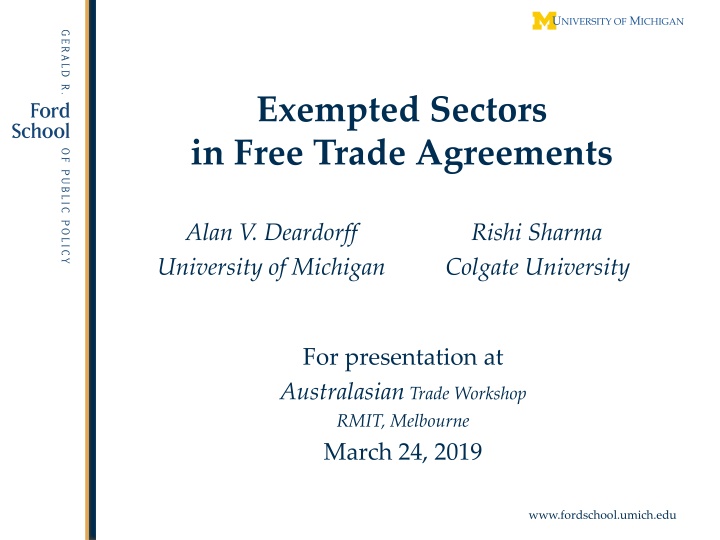
Exempted Sectors in Free Trade Agreements: Correlation Analysis and Motivations
This study delves into exempted sectors in FTAs, analyzing correlations between trade creation and diversion. It explores motivations behind sector exemptions, shedding light on differences between developed and developing countries.
Download Presentation

Please find below an Image/Link to download the presentation.
The content on the website is provided AS IS for your information and personal use only. It may not be sold, licensed, or shared on other websites without obtaining consent from the author. If you encounter any issues during the download, it is possible that the publisher has removed the file from their server.
You are allowed to download the files provided on this website for personal or commercial use, subject to the condition that they are used lawfully. All files are the property of their respective owners.
The content on the website is provided AS IS for your information and personal use only. It may not be sold, licensed, or shared on other websites without obtaining consent from the author.
E N D
Presentation Transcript
Exempted Sectors in Free Trade Agreements Alan V. Deardorff Rishi Sharma University of Michigan Colgate University For presentation at Australasian Trade Workshop RMIT, Melbourne March 24, 2019 www.fordschool.umich.edu
Exempted Sectors These are sectors that retain positive tariffs within an FTA These are more common than I once supposed 2 www.fordschool.umich.edu
Exempted Sectors GATT/WTO requires only that tariffs be eliminated on substantially all the trade between the constituent territories on products originating in such territories. (Note originating. This raises the important issue of Rules of Origin, which I will not address here.) 3 www.fordschool.umich.edu
Exempted Sectors Why I expected them to be a concern: Most likely to be sectors most vulnerable to competition from imports Thus I called them sensitive sectors These are sectors most likely for trade creation Exclusion of sensitive sectors Reduces trade creation, while Retaining trade diversion Thus I thought that exempting sectors was likely to make FTAs welfare-worsening 4 www.fordschool.umich.edu
Exempted Sectors In this paper we look in the data for a correlation between Exempted sectors Trade creation relative to trade diversion We find it, But only for developed countries Correlation is opposite for developing countries Motivation for exempting sectors seems to differ by income 5 www.fordschool.umich.edu
Exempted Sectors Why might low income countries exempt trade diverting rather than trade creating sectors? Two potential reasons: 1. Concern for tariff revenue losses (c.f. Fontagn et al., 2010) 2. Less bargaining power We find some evidence in favor of both of these reasons 6 www.fordschool.umich.edu
Outline Model Equations Graph Data Results 7 www.fordschool.umich.edu
Model Three countries, A, B, and C A and B form an FTA Partial equilibrium Linear supplies and demands for a homogeneous good imply linear Import demand by A: ?? Export supply by B and C: ??,?? 8 www.fordschool.umich.edu
Model ??= ???? ?? ??= ???? ?? ??, ??= ??+ ?? with: Autarky prices: ??> 0, ? = ?,?,? Slopes: ??> 0, ? = ?,?,? Specific tariffs by A on B, C: ?? 0, ? = ?,? ? = ?,? 9 www.fordschool.umich.edu
Effects of FTA Trade Creation: ?? = ??=????? = ?? ?? ? Trade Diversion: ?? = ??=????? = ?? ?? ? Relative Trade Creation: ?? ??=?? ?? 10 www.fordschool.umich.edu
Effects of FTA on Country A Domestic Markets & Injury: Let ??= ???? ??be domestic supply. The change in producer surplus in ? is ??+?? Thus harm to domestic industry is due only to Trade Creation, TC 2 ??? ?? ?? ???= ?0 < 0 2 11 www.fordschool.umich.edu
Effects of FTA on Country A Tariff Revenue: ?= ? ?? + ?0 ?< 0 ??= ? ?? ??0 Thus loss of tariff revenue is due to Trade Diversion, TD, and not at all to trade creation. 12 www.fordschool.umich.edu
Effects of FTA on Country A Gov t Private Sector ??????? ??= ??+??? ? ?? ??? ??0 2? Thus effects on A s total welfare are Private Sector Gain due to trade creation Government Loss due to trade diversion Government Loss of tariff revenue from partner 13 www.fordschool.umich.edu
Graphical Illustration* As with equations above, Three countries: importer A; exporters B, and C Export supply and import demands are linear Countries B and C are identical Two equilibria 0: MFN tariff t on exports of both B and C 1: FTA of A and B: tariff t on exports of C; zero tariff on exports of B *Much of this is an elaboration of material in World Trade Organization, "Causes and Effects of PTAs: Is it all about preferences?", Ch. C: World Trade Report 2011, pp. 92-121. For simplicity www.fordschool.umich.edu
15 Welfare Effects on Country A Import Market Export Supplies Net gain of A s private sector Tariff revenue lost from B C ???+ ??? P ???,??? P ???,??? ? ?0 ?1 ???+ ??? ? ?? ? TD TC ??= ?? TC TD Q Q ? ??1 ? ? ? ?0 = ?0 ?0 ?1 ?1 ? ??= ??+??? ? ?? ??? ??0 2? www.fordschool.umich.edu
Indicator of Trade Creation/Trade Diversion ?? ??=?? where ??, ?? are elasticities of demand and supply. ?? ??1 ?/?? 1 ??= ???? Thus, for given values of elasticities and tariff, relative trade creation is inversely related to the third-country share of imports. 16 www.fordschool.umich.edu
Indicator of Trade Creation/Trade Diversion We therefore regress Exemption from FTA zero tariffs on Third-country share of imports to see whether exemption is negatively or positively related to relative trade creation. 17 www.fordschool.umich.edu
Hypotheses 1. If FTA exemption is to avoid industry disruption, then we expect it to be Negatively related to 3rd-country share of imports (& thus positively related to TC/TD) 2. If FTA exemption is to avoid lost tariff revenue, then we expect it to be Positively related to 3rd-country share of imports (& thus negatively related to TC/TD) 18 www.fordschool.umich.edu
Data Bilateral tariffs: CEPII Bilateral tariff rates, 6-digit HS 3-year averages 2009 2011 MFN tariffs: TRAINS Trade: UNCOMTRADE via CEPII Tariff revenue: IMF 19 www.fordschool.umich.edu
Data Coverage 37 importing countries Mix of high-, middle-, and low-income 240 importer-exporter pairs FTAs from 1998 or later to allow data on pre-FTA trade 2005 or earlier to give time for phasing in cuts EU not included as importer, but does appear as exporter 20 www.fordschool.umich.edu
Importing Countries Country Albania Australia Bosnia and Herzegovina Canada Switzerland Chile Costa Rica Domminican Republic Algeria Guatemala Honduras Croatia Indonesia India Israel Japan South Korea Sri Lanka Morocco *High Income Code ALB AUS* BIH CAN* CHE* CHL CRI DOM DZA GTM HND HRV IDN IND ISR* JPN* KOR* LKA MAR Code MDA MEX MKD MOZ MUS MWI MYS NIC NOR* NZL* PAN PHL SLV SRB UKR USA* VNM ZMB Country Moldolva Mexico Macedonia, Republic of Mozambique Mauritius Malawi Malaysia Nicaragua Norway New Zealand Panama Philippines El Salvador Serbia Ukraine United States of America Viet Nam Zambia 21 www.fordschool.umich.edu
Descriptive Statistics Fraction Exempted Products 0.09 0.24 0.15 0.06 0.10 0.05 0.24 0.09 0.06 0.14 0.14 0.11 0.01 0.20 0.14 0.20 0.19 0.21 0.11 0.11 # of Part- ners 7 2 5 1 9 26 3 5 14 2 2 30 1 1 9 2 1 2 14 4 Fraction Exempted Products 0.11 0.11 0.06 0.30 0.06 0.06 0.03 0.28 0.07 0.24 0.16 0.26 0.44 0.28 0.16 0.18 0.10 0.43 0.23 # of Part- ners 14 4 28 28 7 3 1 1 2 9 2 2 1 3 5 1 3 1 3 Earliest FTA Latest FTA Earliest FTA Latest FTA Importer Importer ALB AUS* BIH CAN* CHE* CHL CRI DOM DZA GTM HND HRV IDN IND ISR* JPN* KOR* LKA MAR MDA 2002 2005 2002 2002 1999 2002 2002 2001 1998 2001 2001 1998 1999 2001 1998 2002 2004 2001 1998 2004 2004 2005 2004 2002 2005 2004 2002 2002 1999 2001 2001 2004 1999 2001 2004 2005 2004 2005 1999 2004 MAR MDA MEX MKD MOZ MUS MWI MYS NIC NOR* NZL* PAN PHL SLV SRB UKR USA* VNM ZMB 1998 2004 1998 2000 2000 2000 2000 1999 1998 1999 2001 2003 1999 2001 2004 2001 2001 1999 2000 1999 2004 2004 2004 2000 2001 2000 1999 2002 2005 2005 2004 1999 2003 2004 2001 2005 1999 2001 22 www.fordschool.umich.edu
Data Note range of Exempted sectors: 1% for Indonesia to 44% for Philippines Sample mean: 16% Number of FTA partners 1 for several, including US 26-30 for Chile, Croatia, Mexico, Macedonia (Countries can have different tariffs on different EU exporters; results the same without them) Sample mean: 6.5; median 3 23 www.fordschool.umich.edu
Results Table 2: Baseline Regressions (1) (2) (3) (4) (5) (6) Dependent Variable: Exempted Product Indicator Third country share 0.065*** -0.195*** 0.076*** (0.007) (0.032) (0.007) Third country share (combined) 0.056*** -0.177*** 0.060*** (0.008) (0.033) (0.008) Observations 112,378 34,796 77,582 243,822 38,654 205,168 R-squared 0.209 0.074 0.259 0.19 0.076 0.207 Imp-Exp FE Yes Yes Yes Yes Yes Yes Not High Inc. Not High Inc. Sample All High Inc. All High Inc. Importer-product clustered standard errors 24 *** p<0.01, ** p<0.05, * p<0.1 www.fordschool.umich.edu
Results Implications of Table 2: High-income countries exempt products where there would have been trade creation Not-high-income countries exempt products where there would have been trade diversion Thus lower-income countries FTAs are more likely net beneficial 25 www.fordschool.umich.edu
Table 3: Regressions with Interaction Terms (1) (2) Dependent Variable: Exempted Product Indicator Third country share (3S) 0.076*** 0.068*** (0.007) (0.008) 3S x high income -0.271*** -0.264*** -0.244*** -0.245*** -0.225*** (0.032) (0.033) 3S x high tariff reliance 0.029** (0.015) 3S x high inc. partner (3) (4) (5) 0.034*** (0.008) 0.002 (0.008) -0.037*** (0.010) (0.032) (0.032) (0.032) 0.077*** (0.016) 0.065*** (0.015) 0.077*** (0.013) 0.066*** (0.012) 3S x exporter larger 0.105*** (0.011) Observations R-squared Importer-Exporter FE Sample Importer-product clustered standard errors *** p<0.01, ** p<0.05, * p<0.1 112,378 0.210 Yes All 112,378 0.210 Yes All 112,378 0.210 Yes All 111,603 0.212 Yes All 111,603 0.212 Yes All 26 www.fordschool.umich.edu
Results Implications of Table 3: As in Table 2, high-income countries exempt sensitive sectors (TC) Countries exempt trade-diverting (TD) sectors if They rely on tariff revenue They import from high income partners They import from larger partners 27 www.fordschool.umich.edu
Table 4: Regressions with Product Fixed Effects (1) Dependent Variable: Excluded Product Indicator Third country share (3S) 0.053*** (0.006) 3S x high income (2) (3) (4) -0.133*** (0.028) 0.062*** (0.006) -0.025*** (0.010) -0.177*** (0.028) 0.056*** (0.015) 0.048*** (0.014) 0.060*** (0.012) 3S x high tariff reliance 3S x high inc. partner 3S x exporter larger Observations R-squared Importer-Exporter FE Product FE 112,295 0.399 Yes Yes 34,425 0.410 Yes Yes 77,366 0.446 Yes Yes Not High Income 111,521 0.403 Yes Yes Sample All High Income All Standard errors are clustered at the importer-product level 28 www.fordschool.umich.edu *** p<0.01, ** p<0.05, * p<0.1
Conclusions Exempted products from FTAs are common In developed countries, they tend to be in sensitive sectors, thus limiting trade creation and the benefits of FTAs In poorer countries they tend to be where there would have been trade diversion due to concern for Tariff revenue Pressure from stronger FTA partners Exemptions are thus more likely beneficial 29 www.fordschool.umich.edu

